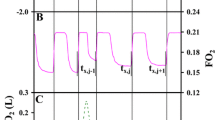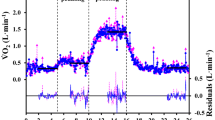Abstract
Purpose
Breath-by-breath (BbB) determination of the O2 flux at alveolar level implies the identification of the start and end points of each respiratory cycle; Grønlund defined them as the times in two successive breaths showing equal expiratory gas fractions. Alternatively, the start and end points of each breath might be linked to the ratio between the exchangeable and non-exchangeable gases. The alternative algorithm is described and evaluated with respect to the algorithm proposed by Grønlund.
Methods
Oxygen and carbon dioxide fractions, and ventilatory flow at the mouth were continuatively recorded in 20 subjects over 6 min at rest and during a cycloergometer exercise including 4 increasing intensities lasting 6 min each. Alveolar BbB oxygen uptake was calculated from the gas and flow traces by means of the two methods at stake.
Results
Total number of analysed breaths was 14,257. The data obtained with the two methods were close to the identity line (average slope 0.998 ± 0.004; R > 0.994; n > 334 in all subjects). Average difference between the O2 uptake data obtained by the two methods amounted to −0.27 ± 1.29 mL/min, whilst the standard deviation of the differences was 11.5 ± 4.6 mL/min. The relative percentage difference was independent from the O2 uptake and showed an average bias amongst subjects close to zero (−0.06 ± 0.15 %).
Conclusions
The alternative timing of the respiratory cycle provided congruent O2 uptake data and made the identification of the start and end points of each breath more robust without introducing systematic errors.




Similar content being viewed by others
Abbreviations
- BbB:
-
Breath-by-breath
- FO2 :
-
Oxygen fraction at the mouth
- \({\text{FO}}_{ 2}^{\text{A}}\) :
-
Oxygen fraction at alveolar level
- FN2 :
-
Nitrogen fraction at the mouth
- \({\text{FN}}_{ 2}^{\text{A}}\) :
-
Nitrogen fraction at alveolar level
- \(\Delta v^{\text{A}}\) :
-
Variation of the alveolar gas volume
- \(\Delta v{\text{O}}_{ 2i}^{\text{S}}\) :
-
Variation of pulmonary oxygen stores
- OG:
-
Original Grønlund’s algorithm
- SG:
-
Simplified Grønlund’s algorithm
- STPD:
-
Standard temperature pressure dry
- t 1 :
-
Starting time of the ith breath
- t 2 :
-
Final time of the ith breath defined on the FO2 trace or on the FO2/FN2 trace
- t 3 :
-
Final time of the ith breath defined on the FN2 trace
- \(v_{i - 1}^{\text{A}}\) :
-
Alveolar volume at the beginning of the ith breath
- \(v{\text{N}}_{ 2}^{\text{A}}\) :
-
Volume of nitrogen exchanged at alveolar level
- \(v{\text{O}}_{ 2}^{\text{A}}\) :
-
Volume of oxygen taken up at alveolar level
- \(v{\text{O}}_{ 2}^{\text{M}}\) :
-
Volume of oxygen exchanged at the mouth
- \(\dot{V}{\text{CO}}_{ 2}^{\text{A}}\) :
-
Alveolar carbon dioxide release
- \(\dot{V}{\text{O}}_{ 2}^{\text{A}}\) :
-
Alveolar oxygen uptake
References
Aliverti A, Kayser B, Macklem PT (2004) Breath-by-breath assessment of alveolar gas stores and exchange. J Appl Physiol 96:1464–1469. doi:10.1152/japplphysiol.01198.2003
Aliverti A, Kayser B, Cautero M, Dellacà RL, di Prampero PE, Capelli C (2009) Pulmonary kinetics at the onset of exercise is faster when actual changes in alveolar O2 stores are considered. Resp Physiol Neurobiol 169:78–82. doi:10.1016/j.resp.2009.08.012
Auchincloss JH Jr, Gilbert R, Baule GH (1966) Effect of ventilation on oxygen transfer during early exercise. J Appl Physiol 21:810–818
Beaver WL, Lamarra N, Wasserman K (1981) Breath-by-breath measurement of true alveolar gas exchange. J Appl Physiol 51:1662–1675
Bland JM, Altman DG (1986) Statistical methods for assessing agreement between two methods of clinical measurement. Lancet 1:307–310
Busso T, Robbins PA (1997) Evaluation of estimates of alveolar gas exchange by using a tidally ventilated nonhomogenous lung model. J Appl Physiol 82:1963–1971
Capelli C, Cautero M, di Prampero PE (2001) New perspectives in breath-by-breath determination of alveolar gas exchange in humans. Pflugers Arch 441:566–577. doi:10.1007/s004240000429
Capelli C, Cautero M, Pogliaghi S (2011) Algorithms, modelling and VO2 kinetics. Eur J Appl Physiol 111:331–342. doi:10.1007/s00421-010-1396-8
Cautero M, Beltrami AP, di Prampero PE, Capelli C (2002) Breath-by-breath alveolar oxygen transfer at the onset of step exercise in humans: methodological implications. Eur J Appl Physiol 88:203–213. doi:10.1007/s00421-002-0671-8
Cautero M, di Prampero PE, Tam E, Capelli C (2005) Alveolar oxygen uptake kinetics with step, impulse and ramp exercise in humans. Eur J Appl Physiol 95:474–485. doi:10.1007/s00421-005-0038-z
di Prampero PE, Lafortuna CL (1989) Breath-by-breath estimate of alveolar gas transfer variability in man at rest and during exercise. J Physiol 415:459–475
Grønlund J (1984) A new method for breath-to-breath determination of oxygen flux across the alveolar membrane. Eur J Appl Physiol 52:167–172
Roecker K, Prettin S, Sorichter S (2005) Gas exchange measurements with high temporal resolution: the breath-by-breath approach. Int J Sports Med 26:S11–S18. doi:10.1055/s-2004-830506
Swanson G, Sherrill D (1983) A model evaluation of estimates of breath-to-breath alveolar gas exchange. J Appl Physiol Respir Environ Exerc Physiol 55:1936–1941
Wessel H, Stout R, Bastanier C, Paul M (1979) Breath-by-breath variation of FRC: effect on VO2 and VCO2 measured at the mouth. J Appl Physiol Respir Environ Exerc Physiol 46:1122–1126
Wüst RCI, Aliverti A, Capelli C, Kayser B (2008) Breath-by-breath changes of lung oxygen stores at rest and during exercise in humans. Resp Phys Neurobiol 164:291–299. doi:10.1016/j.resp.2008.06.002
Acknowledgments
This work was supported by the Department of Medical and Biological Sciences funding of the University of Udine to M. Pia Francescato.
Conflict of interest
None of the authors has conflicts of interest to declare.
Author information
Authors and Affiliations
Corresponding author
Additional information
Communicated by Susan Hopkins.
Electronic supplementary material
Below is the link to the electronic supplementary material.
Rights and permissions
About this article
Cite this article
Cettolo, V., Francescato, M.P. Assessment of breath-by-breath alveolar gas exchange: an alternative view of the respiratory cycle. Eur J Appl Physiol 115, 1897–1904 (2015). https://doi.org/10.1007/s00421-015-3169-x
Received:
Accepted:
Published:
Issue Date:
DOI: https://doi.org/10.1007/s00421-015-3169-x




